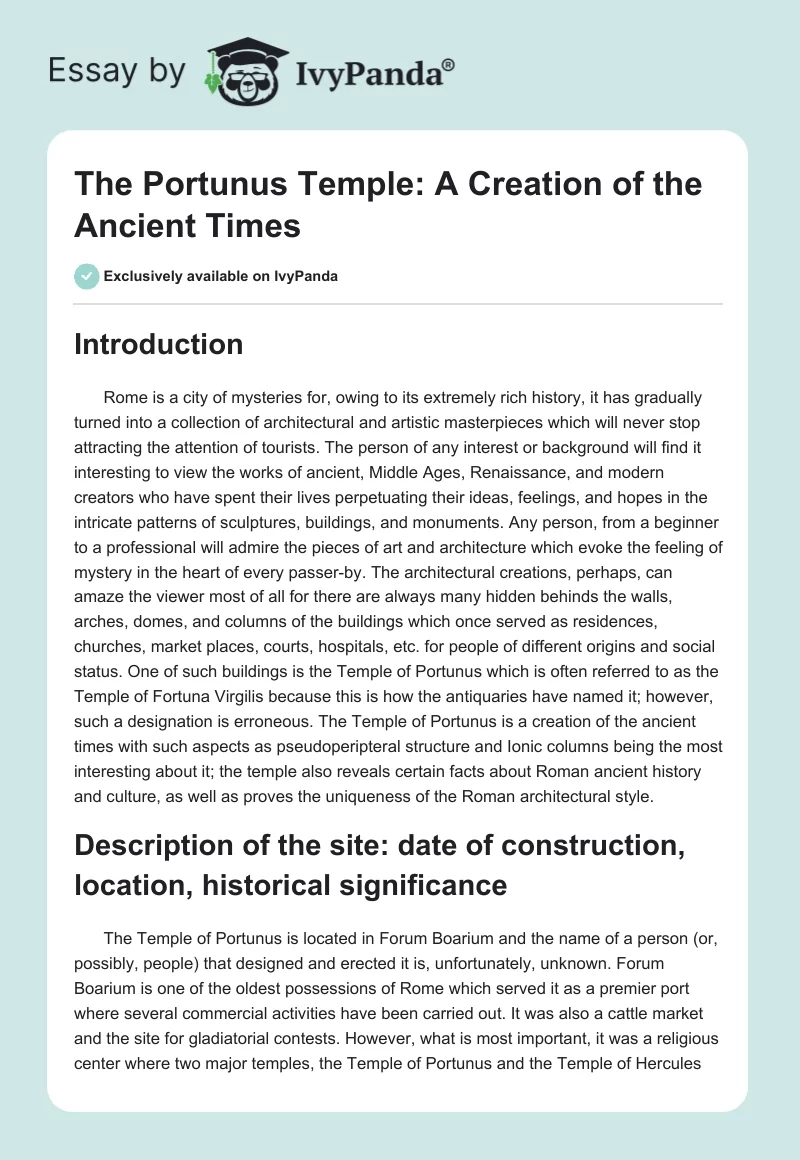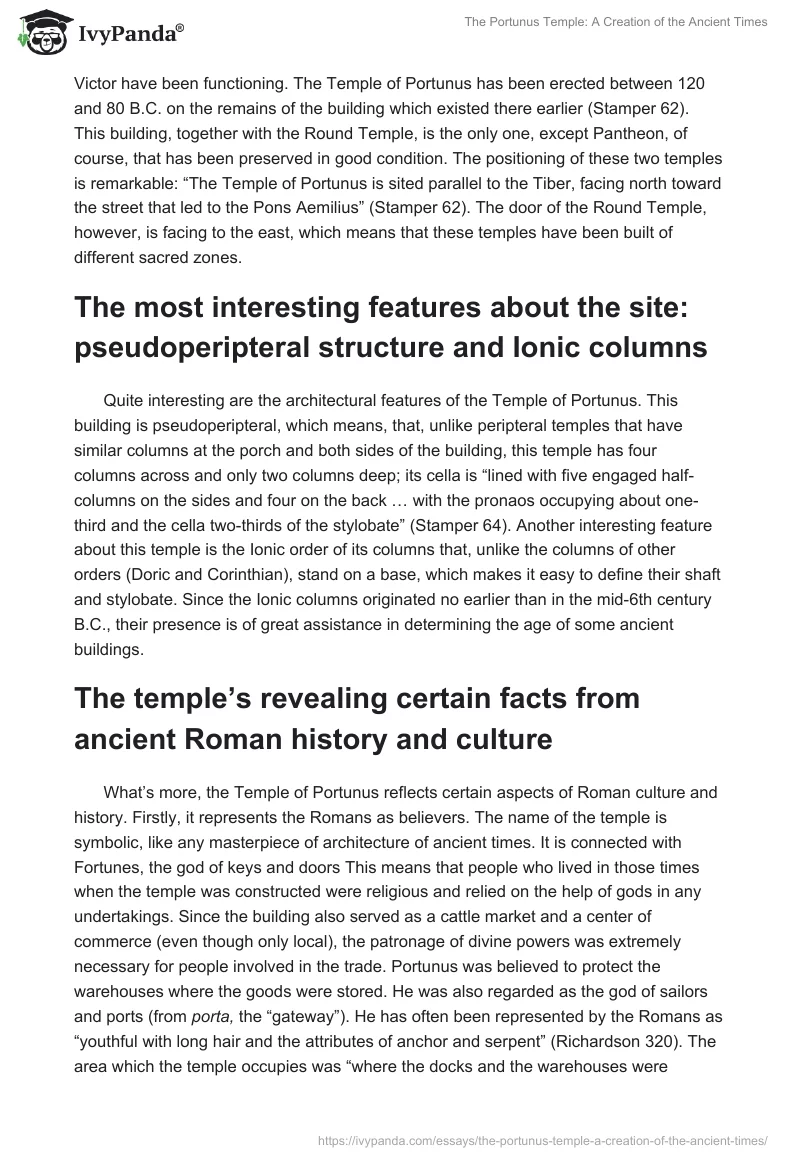Introduction
Rome is a city of mysteries, for, owing to its vibrant history, it has gradually turned into a collection of architectural and artistic masterpieces that will never stop attracting the attention of tourists. A person of any interest or background will find it interesting to view the works of ancient, Middle Ages, Renaissance, and modern creators.
They spent their lives perpetuating their ideas, feelings and hopes in the intricate patterns of sculptures, buildings, and monuments. Any person, from a beginner to a professional, will admire the pieces of art and architecture that evoke a feeling of mystery in the heart of every passerby. The architectural creations, perhaps, can amaze the viewer most of all, for there are always many hidden behind the walls, arches, domes, and columns of the buildings that once served as residences, churches, marketplaces, courts, hospitals, etc., for people of different origins and social status. One such building is the Temple of Portunus, often called the Temple of Fortuna Virgilis because this is how the antiquaries have named it; however, such a designation is erroneous. The Temple of Portunus is a creation of ancient times, with such aspects as pseudoperipteral structure and Ionic columns being the most interesting about it; the temple also reveals certain facts about Roman ancient history and culture, as well as proves the uniqueness of the Roman architectural style.
Description of the site: date of construction, location, historical significance
The Temple of Portunus is located in Forum Boarium and the name of a person (or, possibly, people) that designed and erected it is, unfortunately, unknown. Forum Boarium is one of the oldest possessions of Rome which served it as a premier port where several commercial activities have been carried out. It was also a cattle market and the site for gladiatorial contests. However, what is most important, it was a religious center where two major temples, the Temple of Portunus and the Temple of Hercules Victor have been functioning. The Temple of Portunus has been erected between 120 and 80 B.C. on the remains of the building which existed there earlier (Stamper 62). This building, together with the Round Temple, is the only one, except Pantheon, of course, that has been preserved in good condition. The positioning of these two temples is remarkable: “The Temple of Portunus is sited parallel to the Tiber, facing north toward the street that led to the Pons Aemilius” (Stamper 62). The door of the Round Temple, however, is facing to the east, which means that these temples have been built of different sacred zones.
The most interesting features about the site: pseudoperipteral structure and Ionic columns
Quite interesting are the architectural features of the Temple of Portunus. This building is pseudoperipteral, which means, that, unlike peripteral temples that have similar columns at the porch and both sides of the building, this temple has four columns across and only two columns deep; its cella is “lined with five engaged half-columns on the sides and four on the back … with the pronaos occupying about one-third and the cella two-thirds of the stylobate” (Stamper 64). Another interesting feature about this temple is the Ionic order of its columns that, unlike the columns of other orders (Doric and Corinthian), stand on a base, which makes it easy to define their shaft and stylobate. Since the Ionic columns originated no earlier than in the mid-6th century B.C., their presence is of great assistance in determining the age of some ancient buildings.
The temple’s revealing certain facts from ancient Roman history and culture
What’s more, the Temple of Portunus reflects certain aspects of Roman culture and history. Firstly, it represents the Romans as believers. The name of the temple is symbolic, like any masterpiece of architecture of ancient times. It is connected with Fortunes, the god of keys and doors This means that people who lived in those times when the temple was constructed were religious and relied on the help of gods in any undertakings. Since the building also served as a cattle market and a center of commerce (even though only local), the patronage of divine powers was extremely necessary for people involved in the trade. Portunus was believed to protect the warehouses where the goods were stored. He was also regarded as the god of sailors and ports (from porta, the “gateway”). He has often been represented by the Romans as “youthful with long hair and the attributes of anchor and serpent” (Richardson 320). The area which the temple occupies was “where the docks and the warehouses were located, thus the need for a temple” (Zeleznikar 60). This all testifies to the fact that the Romans of the 1st century B.C. were believers and that they needed faith in gods to carry out business successfully; thus, the temple under consideration reflects cultural and historical aspects of the then society.
Topical importance of the temple: a mixture of different architectural styles
Finally, the topical importance of the Temple of Portunus consists in its being eclectic, which characterizes it as a creation of Roman architecture. The temple is a mixture of numerous styles of architecture, which makes it hard to define what exactly is so peculiar about this temple. In general, the temple’s walls and ceiling are organized by the Etruscan patterns. However, this is where the unknown Roman architect managed to add mystery to his creation:
The high podium is accessible only at the front, with its wide flight of steps. Freestanding columns are confined to the deep porch. But the structure is built of stone (local tufa and travertine), overlaid originally with stucco in imitation of the gleaming white marble temples of the Greeks. The columns are not Tuscan, but Ionic, complete with flutes and bases, and a matching Ionic frieze. (Garnder, Kleiner, and Mamiya 171)
Therefore, the temple has Greek and Etruscan elements, though at this it remains uniquely Roman. The main reason for this is that the Romans added the main entrance into the building, which made the temple distinctive from the Greek ones which can be entered from different sides. Thus, the topical importance of the Temple of Portunus consists in this building presenting Roman architecture as unique, even though it utilized the elements of other architectural styles.
Conclusion
In conclusion, though the exact age of the Temple of Portunus is impossible to identify, several facts about this building can be discovered from its structure making it possible to describe architectural directions of those times, as well as certain historical and cultural aspects of the then society. Thus, the name and location of the temple show that the Romans of the 1st century B.C. have been involved in trade and were religious, while the mixture of the temple’s Greek and Etruscan styles reveals the uniqueness of the Roman architecture due to pseudoperipteral structure which it achieves with the help of Ionic columns.
Works Cited
Gardner, Helen, Kleiner, Fred S., & Mamiya, Christin J. Gardner’s Art through the Ages: The Western Perspective. London: Cengage Learning, 2005.
Richardson, Lawrence. A New Topographical Dictionary of Ancient Rome. Baltimore, MD: The Johns Hopkins University Press, 1992.
Stamper, John W. The Architecture of Roman Temples: The Republic to the Middle Empire. Cambridge: Cambridge University Press, 2005.
Zeleznikar, Alan. Rome Explorations: The Ancient Rome Walking Tour. Victoria BC: Trafford Publishing, 2002.


